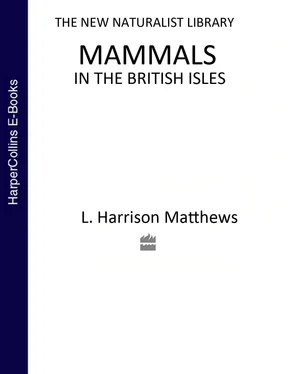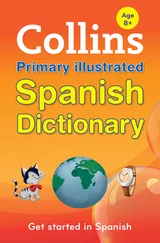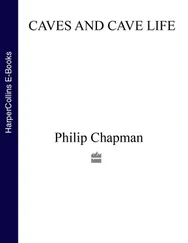The ship rat, Rattus rattus , is commonly black in colour, but also occurs as two other forms, brown with grey underside or brown with nearly white underside. It was once widespread but is now found, with few exceptions, solely in the neighbourhood of sea ports, where it lives only in buildings.
The common rat, Rattus norvegicus , is larger than the ship rat and has comparatively smaller eyes and ears; the fur is greyish brown, lighter beneath. It lives in buildings of all sorts but also inhabits rubbish tips and hedgerows far from them. In addition it commonly lives in the open on the coast, especially on the shores of estuaries and salt marshes. It is found throughout the British Isles and off-lying islands, having replaced the once abundant ship rat. Charles Waterton, the early nineteenth century naturalist of Wakefield, expressed 150his extreme Jacobin loyalty by calling the common rat the ‘Hanoverian rat’ because it was introduced soon after King George I’s accession in 1714 – a name that was sometimes used by other writers.
Family Gliridae
Our only native member of this family is the dormouse, Muscardinus avellanarius , distinguished by its orange-brown fur, long whiskers, and hairy, almost bushy tail. It lives in broad-leaved woodlands, coppices and overgrown hedgerows, building a globular nest of bark fibre, grass, and leaves several feet, sometimes yards, above ground among shrubs. Apart from the bats the dormouse and the hedgehog are the only indigenous British mammals that hibernate; the winter nest is usually made underground or among litter at ground level. The dormouse occurs sparsely throughout England and Wales, becoming scarcer in the north, and is absent from Scotland and Ireland. Another member of the family, the fat dormouse, Glis glis , was introduced at Tring in Hertfordshire in 1902, and has since persisted and spread over a small area of the Chiltern Hills. It closely resembles a small grey squirrel, but has dark rings round the eyes. It inhabits woods, orchards and gardens, and, like the common dormouse, it hibernates, often in the roofs of houses.
Family Hystricidae
The large South American coypu, Myocastor coypus , which produces the fur known commercially as ‘nutria’, escaped from fur farms in the early 1930s and established feral populations in several places, mainly in East Anglia. It is a large aquatic rodent reaching a length of a yard from nose to tail, looking like an enormous brown rat with webbed hind feet, blunt nose, small eyes and ears, and orange coloured enamel on the front of the incisor teeth. In East Anglia the population increased enormously in spite of heavy mortality in severe winters, so that the animals became a pest to agriculture and a threat to the stability of river banks. Since the early 1960s official control measures have greatly reduced its numbers.
ORDER CETACEA
Although seventeen species of whales and dolphins have been recorded as British, mainly because they have been found stranded on our coasts from time to time, they cannot be regarded as part of the British fauna as dealt with here – the wreck of a foreign ship on our coasts does not give its crew British nationality or make it part of the native population.
ORDER CARNIVORA
Of the ten indigenous species of beasts of prey two have been extinct for centuries; the remaining eight have been joined by a recent introduction derived from animals escaped from fur farms.
Family Canidae
The wolf, Canis lupus , was exterminated some 500 years ago in England and Wales, but survived in remote parts of Scotland and Ireland for another 250 years. Its descendent, perhaps with an admixture of other ‘blood’, the domestic dog, has some effect upon the country’s ecology, killing according to one authority 146some 6,000 sheep a year – in 1978 4,639 were killed and 3,833 injured – and every day depositing 500 tons of dung and a million gallons of urine ‘on Britain’s pavements and parks’, equal to the sewage from four million people.
On the other hand the fox, Vulpes vulpes , is found everywhere in Great Britain and Ireland and in some of the islands. Its abundance is due to its adaptability to various habitats and foods, to its nocturnal and crepuscular habits, and to its tolerance of the near neighbourhood of man as shown by its recent extension of habitat into the suburbs of towns.
Family Ursidae
The brown bear, Ursus arctos , has been extinct in the British Isles for a thousand years; its natural distribution covers all of northern Europe, Asia and America. It varies greatly in size, from the comparatively small European race to the enormous ‘grizzlies’ of Kodiak Island off the Alaskan coast, as large as the ‘Cave bear’ that lived in the British Isles before the last glaciation of the Pleistocene epoch.
Family Mustelidae
The family consists of small to medium-sized carnivores, the British species characterised by long bodies and short legs. The pine marten, Martes martes, as large as a rabbit, with deep brown fur, a yellow patch on the throat, and long bushy tail, is an inhabitant of woodlands, where it feeds mainly on small birds and rodents. It is an agile climber. It was formerly found throughout the British Isles but has long been extinct except in northern Scotland, the Lake District, north Wales and Ireland.
Although the pine marten has been successfully destroyed as vermin in most of Great Britain, two other species, the stoat and the weasel, both subjected to similar persecution, have been able to remain plentiful. The larger of the two, the stoat, Mustela erminea , with head and body length of about a foot in males but some two inches shorter in females, is brown above, off-white below, and has a black tip to the tail. In the northern part of its range the winter coat is white with black tail tip; but in the southern part it resembles that of the summer; partly white examples occur in winter between the extremes of its range. Stoats are found throughout the British Isles and on some of the off-lying islands; those in Ireland, being smaller and having less white below, are recognised as a separate subspecies M.e.hibernica.
The weasel, M. nivalis , about four inches shorter than the stoat in both sexes, is similar in colour but does not have a black tail tip. The winter coat is not white in British weasels, though further north on the continent it is. Weasels feed mainly on voles and mice, whereas stoats take larger prey as well, especially rabbits. They are found throughout the mainland of Great Britain and some of the islands, but not in Ireland.
The polecat, M. putorius , is larger than the stoat but similar in build; the fur is brown with a white patch on the face between eyes and ears, the two often joining to form a bar. There is a white patch under the chin extending up onto the muzzle, and the edges of the ears are white. The ferret is a domesticated form of the polecat, perhaps with some hybridisation with the Steppe polecat of eastern Europe which may be specifically different; as it breeds successfully with the polecat, and some specimens cannot be distinguished either by colour or skull structure, the specific name, M. furo , for it seems superfluous. Albino ferrets are popular with the breeders and users of these animals. The polecat is an unselective carnivore; it was exterminated as vermin over most of Great Britain by the beginning of the twentieth century, but remains common in the greater part of Wales and the Welsh Marches.
The mink, M. vison , a native of North America, escaped from fur farms and became established as a feral member of our fauna in the 1950s; it is now widespread in Great Britain and common in many places – it is also present less widely in Ireland. The mink, about the size of a polecat, with a rather bushier tail, has very dark brown fur with white spots on the chin and throat. It is an unselective carnivore, and the effect of its activities on the native fauna has yet to be assessed – it may not be as destructive as some people have feared.
Читать дальше












